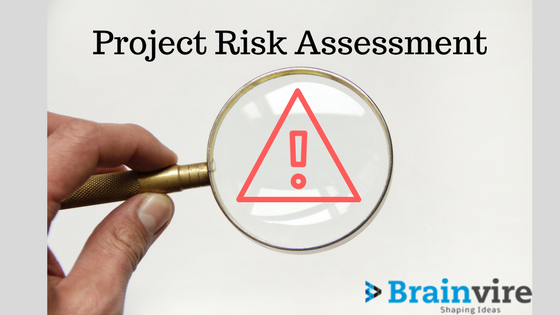In any domain be it Infrastructure, Medical, IT etc tasks are bounded with risks. Many variations are observed in terms of risk types because risk factors totally depend on types of projects. Project implementation is not restricted to planning, designing, coding, and delivery one of the most important pillar that is risk assessment is to be carried out priorly before any project development kicks off.
Risk assessment: Analyzing factors that can adversely affect the ongoing project development process or after development completion.

If a project gets developed without any obstacles and client is handed with the final product and later when the client is using the same he/she faces technical issues which weren’t even given a thought during the implementation phase, such project deliveries can pull your firm shutters down. Hence, it is essential to have Risk Management team involved in the project from day one. Skilled managers, ideally those who have undergone a structured project management course, will help to create risk-proof planning, and the further loop of design and development will surely come across minimal hindering factors.
Get your safety wall built before any of the below risk threats breaks down the loop of project development cycle,
- New technologies & methods: As technology market is booming every other day there is update or arrival of new technologies & approaches, this frequent change increases chances of flaws. As it is not necessary everyone can have hands on new technologies in an overnight, it takes some time to shift or adapt the same. And blind implementation without any training or guidance will pile up the errors.
- Inaccurate user or functional requirements: Project base is always made strong using requirements. Each and every user’s role, their functionalities, accessibilities & permissions, prototyping etc if not identified accurately then the entire base will get developed on weak pillars.
- Modern Application & system architecture: Development is solely depended on architecture; if wrong choice is made in choosing technology, method or procedure then unwelcomed consequences will rise.
- Resource Allocation: Depending on project complexities, resources in terms of people will vary it might happen that in middle of an ongoing project you need to hire a proficient person. In complex projects team of unskilled or inexperienced people, lack of reviewers or subject matter or domain experts etc will not be able to accomplish the target.
- Investment/Funding: Improper maintenance of fund ledger in terms of cost estimations and wayward usage of the same will drown entire project. Till long run, such improper management of funding would be able to provide oxygen to project.
- Project Deadlines: If a client needs a project to be delivered on an urgent basis and prepone’s project date or team crosses the delivery deadline in both cases, consequences will directly reflect entire schedule, project investment, resources allocated schedule etc.
To mitigate or completely remove above risks following steps can be implemented:
- Risk assessment meets with entire project implementation team will help in bifurcating rights and wrongs. Along with planning from each and every team personnel one can identify risk factors, for example in a software development project design team will be very well aware some flaws that can come in creating UI of a project and accordingly they will have alternative plans on hand in advance. Similarly, developers and coders will be able to analyze complicated flaws that can come during development. Hence, such meetings can give flaw predictions and based on it backup plans can be lined up for the same.
- Risk Identifier meter: During meetings, all glitches can be labeled with identifiers that is segregate flaws under High, Medium, and Low titles. Such approach will help to set priorities,
- High: Risk classified under this categories can be red highlighted, meaning they can’t be ignored as such risks severely affects the entire project cycle and organization can break down completely is steps not taken on an immediate
- Medium: Risks which are moderate, they can be delayed for less time but if solved at once then it is beneficial.
- Low: Apart from above two, rest can be accommodated here. Low priority risk can be solved easily comparatively in less time. So, they should be dealt later but should not be neglected.
Paper-based risk assessment approach V/s Software based risk assessment approach:
In earlier times due to lack of advanced technologies, risk assessment was carried out manually. Piles and piles of papers were filled with team members’ tasks and from step one that is project planning to delivery all were stocked up manually. Such approach declines the rate of eradicating flaws because some paper can go missing, there are high chances of human errors while entering details and so on and above all to manage all this takes immense time.
But as technology market escalated, different risk assessment softwares conquered the traditional paper-based approach. Using risk assessment software, entire project can be managed within clicks from anywhere around the globe. These softwares are available for all digital devices and they can be used for any project belonging to any domain. The software interface provides easy to add and analyze project risks factors and above all, within few minutes risk identifiers of every project task can be inputted. Risk assessment softwares are secure and there are no chances of data loss.
Every flaw be it minor or major if veiled then they will mount up and it will be impossible to solve all in one go. So, accurate risk assessment and eliminating steps should be implemented to deliver bug-free projects, services, and products.
Related Articles
-
Must Know Reasons Why Cloud Computing In eCommerce Makes Sense
You have to be living under a rock if you have no idea or are yet to associate with eCommerce. As of 2023, eCommerce is rising and is expected to
-
Top Insurance Claims Management Software in 2025
Practical and user-friendly software is crucial for the insurance industry, as it has the potential to transform the way operations are handled. By simplifying complex, repetitive tasks, convenient and flexible
-
Increasing Importance of Outsourcing Software Development In Today’s Global Business Scenario
Talking About Increasing Importance of Outsourcing Software Development In Today’s Global Business Scenario, Now-a-days it has become very important to support uprising business with a robust web-based software programs so


